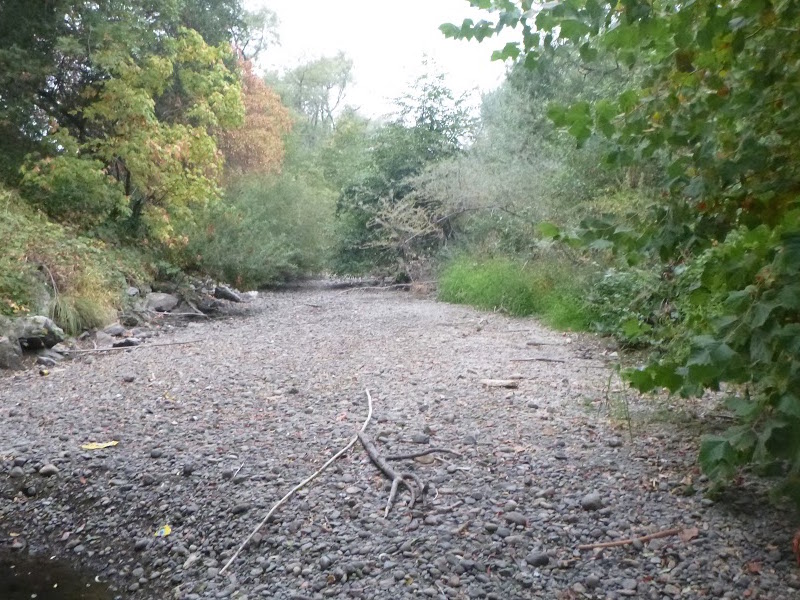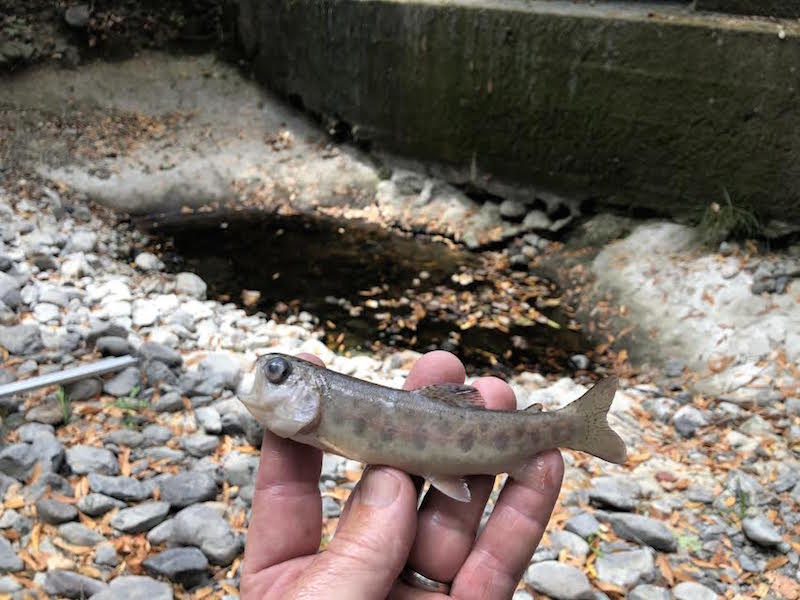Lack of Rainfall, Continued Pumping Cause Sonoma Creek and Its Tributaries to Run Dry
“Try to give the creeks a break for the rest of this year.” That’s the message from Sonoma Ecology Center’s Senior Scientist and Research Program Manager Steven Lee, speaking especially to creekside landowners who draw water from the creeks—or from shallow groundwater next to the creeks—for personal use.
Lee oversees Sonoma Ecology Center’s stream monitoring work throughout the Sonoma Valley watershed. This year, he says, has been a bad one for streamflow due to the unusually dry winter, which brought the Valley only about half of its normal rainfall.
“Streamflow is really, really low,” he said. By August of this year, the flow “was only a quarter of our lowest flow last year, which occurred in October.”
Lee took a picture in mid-August of a dead juvenile steelhead which had become trapped in an evaporating pool in the streambed at the confluence of Sonoma and Yulupa Creeks. Without flowing water or cool, deep pools to find refuge in, steelhead and Chinook populations are vulnerable—and ecologists say these anadromous fish species are bellwethers for other aquatic species, and for human welfare, too.
Every six months, Sonoma Ecology Center’s research team completes a streamflow monitoring survey from Sonoma Creek’s upper watershed in Sugarloaf Ridge State Park down to Nathanson Creek near Schellville—work that is funded by Sonoma Water, the state WCB Stream Flow Enhancement program, and the Sonoma Valley Groundwater Sustainability Agency. Their latest survey wrapped up earlier this month, and according to Research Scientist Wendy Hayes, “Out of 56 sites, 34 were dry or only had small pools with no surface flow.” Although certain tributaries tend to run dry this time of year, that’s a half-dozen more going dry than usual.
 Hayes pointed to Sonoma Creek at the Watmaugh Road bridge, which “usually has at least ankle- to shin-deep water this time of year.” Looking upstream, the site is bone-dry. She added, “Stream flows are less than half what SEC has measured within the past five years in September or October.”
Hayes pointed to Sonoma Creek at the Watmaugh Road bridge, which “usually has at least ankle- to shin-deep water this time of year.” Looking upstream, the site is bone-dry. She added, “Stream flows are less than half what SEC has measured within the past five years in September or October.”
“Now is definitely the time to get more of our community working towards efficient water use and exploring options including storing water in tanks or ponds during winter that could be released to the creeks in dry summer,” Hayes said. “Our creeks need us and we need the creeks.”
Streamflow Solutions
Some landowners have noticed. One resident with extensive creekside property in Glen Ellen examined Sonoma Ecology Center’s data and found it to be “Very interesting, and rather alarming.” This landowner, who normally does divert some water from the creek during the dry season for irrigation, has elected to avoid doing so for the rest of the summer.
Besides curbing water consumption, there are tried-and-true methods for improving water efficiency and keeping streamflow as high as possible during the summer months. Lee himself just completed a rainwater catchment system on his own Glen Ellen property that will allow him to store nearly 60,000 gallons of rainwater to irrigate his garden, orchard and landscaped areas.
“At first I was thinking of employing a pond, then a large 50,000-gallon storage tank,” he said, “but ultimately settled on a collection of 5,000-gallon tanks tied together in cascading fashion so that roof and drainage water flows from one to the other. A pump is connected to the lowest set of tanks to deliver water back up to the irrigated areas.”
Besides capturing and storing winter rainwater for personal use, another good land-management practice—especially for Sonoma Creek’s upper watershed—is capturing it in ponds or marsh areas and allowing the water to sink into the ground and recharge groundwater, which in turn replenishes creeks during the dry months. Other systems similarly catch the water in storage tanks for summer release, mimicking the effect of natural springs in replenishing creeks during the dry months.
These and other solutions are propounded in a soon-to-be-released Sonoma Ecology Center report, “Upper Sonoma Creek Habitat Restoration Vision,” developed by research and restoration experts with input from dozens of Sonoma Valley property owners.
Sonoma Ecology Center is currently able to assist local landowners with water storage and conservation strategies; those interested may contact Steven Lee at steve@sonomaecologycenter.org.

